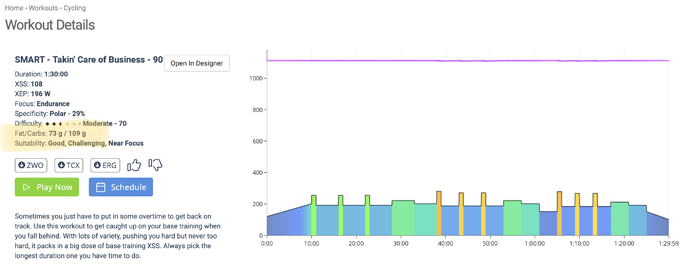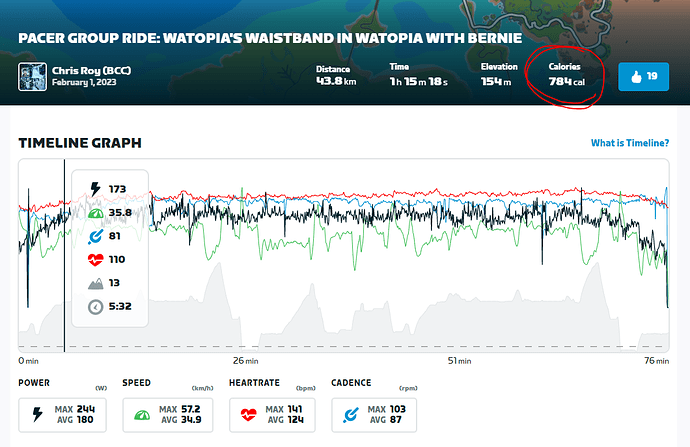I am not so sure about the fat & carb consumption to be honest. I did a total of 8hrs on Zwift today. All LSD riding. According to Xert i only burned 5grams of carbs over the 8hr period. I am not so sure this can be true even though it was in the fat burning zone. So what happened then to the 30g/hr carbs i consumed during the ride?
They were transformed into and stored as fat ![]()
Honestly, I have no clue how this calculation works and I’ve stopped looking at it…
First off, basal metabolism. Secondly, how dialed in is your signature in regard to LTP?
Thirdly, it’s just another algorithm.  Doesn’t mean it works the same for everyone in all situations.
Doesn’t mean it works the same for everyone in all situations.
I use it to more as a warning to slow down on long rides. May as well burn some belly fat while you’re out there.
The bigger question is who the heck rides 8 hrs on Zwift? That would be pure hell to me. 
I’d rather binge on Netflix series. 
I did a 7hr ride today, pretty much on my limit for that length (which of course is way below TP). Xert reckons I burned 500g of fat, and 70g of carbs. I wish that were true, but I doubt it. I guess the algorithm works better for high intensity short rides, much like many of the metrics in Xert
Did an 11 hr ride yesterday and used the fat carb app to guide my effort to avoid running out of energy. It worked, normally I feel the wall at about 3200 calories burned, able reach 6100 calories before I felt the same. Tried to maintain just under LTP and maintain a 1 gm fat to 1 gm carb….usually degraded to 1 gm fat to 2 gm carbs in the hills
Fueled along the way as needed, you only have 500 gm of carbs as glycogen when you start the day. Managing this carb reserve is essential for long rides
Interesting, I suspect your HIE is slightly underestimated, given your Peak Power.
I’d be happy to make a few adjustments on your account - those changes would likely bring your LTP down a bit and shift the breakdown of Carb/Fat for that activity a little more heavily towards carbs. Let me know 
Sure, let’s try a little fine tuning
Not sure it adds value. but additional information to add a little color…
- Garmin/Strava calories burned = 6566 Vs Xert =5907 for the entire ride
- Did two breakthrough efforts on hills at 3hr and 8 hrs - it dropped my HIE by -0.2kj, Gain TP +4W. (With out these two efforts I might have avoided feeling “the wall” at 6100 cal)
- Describe “the wall” as starting to feel exhausted (out of breath), breath rate increases and goes shallow but can still maintain LTP with moderate to significant effort, Symptoms decline with reduced effort.
Hi @ManofSteele, thanks for your help (assuming that was to me?). Why would my HIE be underestimated - does that mean I need to do some more 1min max efforts to calibrate? I reckon my TP is overestimated by about 15W in case that’s also related.
Ha ha guess that was for you. Sorry for stepping on your thread
 all good. I stepped on someone else’s thread!
all good. I stepped on someone else’s thread!
Is there a way to see my personal graph as shown in that article. Or a calculator of some sorts to show the estimated fat/carbs consumption for an given power input?
The way I do it now is build custom workouts at certain intensities for an hour and look at the workout summary page, but that is quite cumbersome.
Hi @jasperdeman ,
The graph we show there is only for illustrative purposes, we don’t display that chart anywhere for the user.
That being said, you can view the Carb/Fat breakdown for each workout in the workout preview page - we did this to help users better estimate their nutrition needs for various workouts. Here’s an example for the TCOB - 90 workout (using my signature):
Another invader to this thread, but I thought the topic was similar enough. I have a question regarding calorie calculation. I realise that carb/fat split might be a little off but is a great estimate for nutrition planning and further understanding effort. I’ve seen some fairly different calorie calculations come from Zwift and Xert when using EBC. Power and HR are the same in both apps from the same activity but the calories are very different, I also make sure my weight matches between all apps. I have Xert controlling power and Zwift only reading power; both from the same source. Zwift also has my FTP around 15 Watts lower than Xert, I let them both auto-adjust; and both did so 1 day before this effort. I don’t expect Zwift to be overly accurate for some things but find on some rides the calorie count is quite similar and others it is not. I know for example that the distance calculation is much more realistic with Xert, Zwift always convinces me I’m elite until I go ride with real humans. Any insight is always appreciated.
Calories are calculated by adding up all the work you do from your power meter (not HR… that’s just more of an estimate) and then dividing by your gross efficiency (how much energy your body burns to generate work measured by the power meter). Generally 22-23% is what has been documented and what Xert uses. In the end, the math is simply total work in total work kJ * 1.1 to convert into kcalories, when you factor in the conversion from work to kcalories. Any other method has to presume some other efficiency value and as far as I know, there is no widespread consensus. 22-23% gross efficiency is well established based on research, however.
Using HR is another approach but is likely much further from being representative of the actual energy you burn since it first needs to convert to work performed based on your weight and then convert that to kcalories. A power meter just gives that result with greater accuracy so HR isn’t needed.
Thanks @xertedbrain, that makes perfect sense. I poked around a little and found Zwift uses around .25 conversion to account for efficiency of power. Numbers matched bang on when using the different conversions.
Not sure if you have any research available but would be interested to read anything on efficiency rates as Watts go up. For example is the amount of calories the body needs to expend the same to go from 100>>>200 watts as it is to go from 400>>>500 watts. I figure this is very hard to measure and would likely only be repeatable in a highly controlled lab environment and would depend largely on levels of training for an individual. Thought any change might be similar enough though that it could be used as a rough barometer. Also wondering if there is any scientific papers that have looked at elevated calorie use post strenuous activities?
I think this is straying from the software a little and really appreciate the Xert staff and community that through their patience and willingness to share end up providing a lot of solid exercise physiology training. The school of Xert.
I have read that the more of an anaerobic type rider you are the less efficient nyou tend to be. 19-21% isn’t unusual in those cases. Obviously doesn’t apply to Elites as if it did they wouldn’t be elite.
This is one of the best features from Xert. I use this all the time and it helps me manage by nutrition and avoid bonking or running low on carbs. I regularly ride 200 miles at endurance pace. If you are riding a LSD only eat carbs to match the burn rate, in your case the carbs will be stored as glycogen or fat depending on how much cardio you have done in the last 24-48 hours.
In your case the app was telling you you did not need to eat carbs during your ride.
I have tested it and I trust it, as long as your profile is accurate.
I have tested it with both flash glucosemeter and with blood glucosemeter. In the end, I concluded that I need to eat 25 grams of carbs every time the fields indicates that I have burned 40 grams of carbs. I also drink a bottle of sportsdrink every hour (except the first and last hour).
How do you use this data field during a ride to drive your in- ride fueling needs? Replace carbs burnt? I was always just replacing ~1/3 of kilojoules in calories.
Interesting! Could be Xert underestimating, or the carbs replenished glycogen. Worth double-checking!


